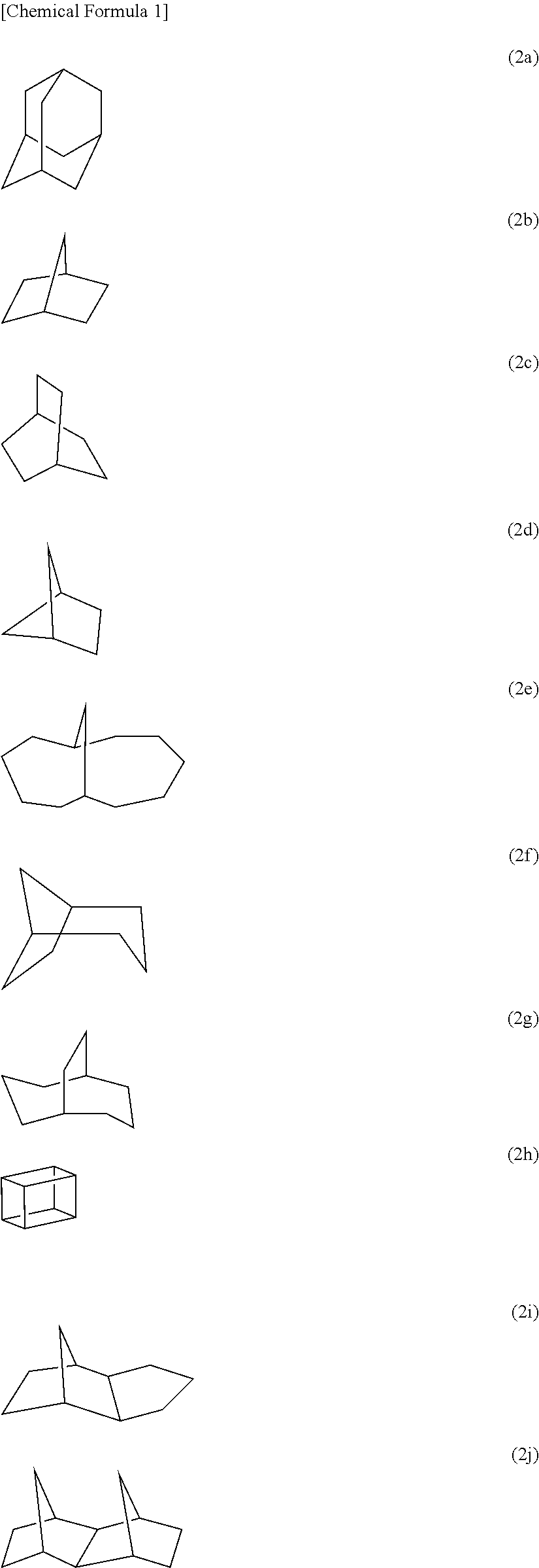Photoresist composition
a composition and composition technology, applied in the field of photoresist composition, can solve the problems of difficult to give resist patterns with less ler, rough top surface and sidewall surface of patterns, and recently become a serious problem, and achieve the effects of avoiding pattern collapse, excellent etching resistance, and easy reaction
- Summary
- Abstract
- Description
- Claims
- Application Information
AI Technical Summary
Benefits of technology
Problems solved by technology
Method used
Image
Examples
preparation example 1
[0086]In a 200-mL three-necked flask equipped with a Dimroth condenser, a thermometer, and a stirring bar were placed 2.18 g of 1,3,5-adamantanetriol, 7.82 g of hydroquinone, 13.51 g of p-toluenesulfonic acid, and 56.67 g of n-butyl acetate, followed by stirring thoroughly. Next, the flask was purged with nitrogen and submerged in an oil bath heated to 140° C., to start heating with stirring. After being kept heating under reflux for 2 hours, the flask was cooled.
[0087]The cooled reaction solution was transferred from the flask to a separatory funnel, washed with 80 g of distilled water, and further washed with five portions of 65 g of distilled water. The washed reaction solution had a weight of 55.4 g. The washed reaction solution was poured into 500 g of n-heptane, to deposit orange fine particles. The fine particles were collected through filtration, dried at 60° C. for 12 hours, and thereby yielded 5.8 g of a polyol compound 1. The prepared polyol compound 1 was subjected to a ...
preparation example 2
[0088]In a 200-mL three-necked flask equipped with a Dimroth condenser, a thermometer, and a stirring bar were placed 0.739 g of 1,3,5-adamantanetriol, 3.98 g of hydroquinone, 18.01 g of p-toluenesulfonic acid, and 18.01 g of n-butyl acetate, followed by stirring thoroughly. Next, the flask was purged with nitrogen and submerged in an oil bath heated to 140° C., to start heating with stirring. After being kept heating under reflux for 2 hours, the flask was cooled.
[0089]The cooled reaction solution was transferred from the flask to a separatory funnel and washed with six portions of 20 g of distilled water. The washed reaction solution had a weight of 15.6 g. The washed reaction solution was poured into 100 g of n-heptane, to deposit orange fine particles. The fine particles were collected through filtration, dried at 60° C. for 12 hours, and thereby yielded 2.2 g of a polyol compound 2. The prepared polyol compound 2 was subjected to a GPC measurement and found to have a weight-ave...
preparation example 3
[0090]In a 200-mL three-necked flask equipped with a Dimroth condenser, a thermometer, and a stirring bar were placed 2.18 g of 1,3,5-adamantanetriol, 7.82 g of hydroquinone, 13.51 g of p-toluenesulfonic acid, and 56.67 g of n-butyl acetate, followed by stirring thoroughly. Next, the flask was purged with nitrogen and submerged in an oil bath heated to 100° C. to start heating with stirring. After being kept heating under reflux for 2 hours, the flask was cooled.
[0091]The cooled reaction solution was transferred from the flask to a separatory funnel, washed with 80 g of distilled water, and further washed with five portions of 65 g of distilled water. The washed reaction solution had a weight of 55.4 g. The washed reaction solution was poured into 500 g of n-heptane, to deposit orange fine particles. The fine particles were collected through filtration, dried at 60° C. for 12 hours, and thereby yielded 5.2 g of a polyol compound 3. The prepared polyol compound 3 was subjected to a G...
PUM
| Property | Measurement | Unit |
|---|---|---|
| wavelength | aaaaa | aaaaa |
| wavelength | aaaaa | aaaaa |
| wavelength | aaaaa | aaaaa |
Abstract
Description
Claims
Application Information
 Login to View More
Login to View More - R&D
- Intellectual Property
- Life Sciences
- Materials
- Tech Scout
- Unparalleled Data Quality
- Higher Quality Content
- 60% Fewer Hallucinations
Browse by: Latest US Patents, China's latest patents, Technical Efficacy Thesaurus, Application Domain, Technology Topic, Popular Technical Reports.
© 2025 PatSnap. All rights reserved.Legal|Privacy policy|Modern Slavery Act Transparency Statement|Sitemap|About US| Contact US: help@patsnap.com



